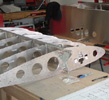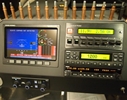


random user submitted photo
Fuel efficiency sonex ?
12 posts
• Page 2 of 2 • 1, 2
Re: Fuel efficiency sonex ?
gammaxy wrote:I fly across Alabama pretty often at full throttle. I prefer to fly around 3500 feet for the trip, but turbulence often means I end up around 6500 feet.
In a naturally aspirated engine - you can't make 100% power at altitude. Thinning air means you have to lean to maintain the correct mixture. You will burn less fuel and make less hp.
So "full throttle" (correctly leaned) is not 100% power. At 10,000ft above a standard MSL you can only make 74% of the rated engine power
The contra is the thinner air means less drag so the plane flies faster in the thinner air - to a point.....when you run out of lift.
You really only need the excess of power to help get up there. Not to maintain flight once up there.
--
I suppose it is possible that you CAN get closer to the Sonex claimed numbers - but only if you ignore the climb burn and just measure the straight line at altitude. But even at 10,000ft and 74% of power - My AeroVee would come out at: 3gph at 100knots TAS. So 33 nautical miles to the US gall. So 38mpg.
--
Maximum fuel ENDURACE - Carson Airspeed
Maximum Endurance. It has been shown that, while the speed for maximum L/D yields the least fuel consumed per unit of distance, there is also a speed for the least fuel per unit of velocity, essentially, the best compromise between speed and fuel economy.
If using Carson airspeeds – care should be taken when flying into a headwind component where the extra time spent in the headwind may more than offset or even negatively impact the fuel savings.
The rule of thumb calculations are:
Vmax endurance = Best Glide Speed/1.316
- For my aircraft this is 46 KIAS (53 mph)
Vmax range = Best Glide Speed
- For my aircraft this is 60 KIAS (69 mph)
Blending these numbers:
Voptimum cruise = (Best Glide Speed) * 1.316
For my aircraft this is 79 KIAS (91 mph)
Graeme JW Smith
-

GraemeSmith - Posts: 939
- Joined: Sat May 18, 2019 8:58 am
- Location: RI
12 posts
• Page 2 of 2 • 1, 2
Who is online
Users browsing this forum: No registered users and 19 guests







